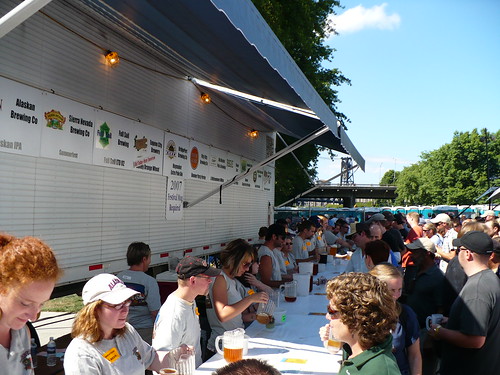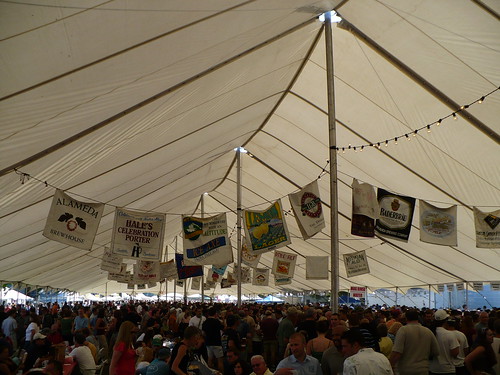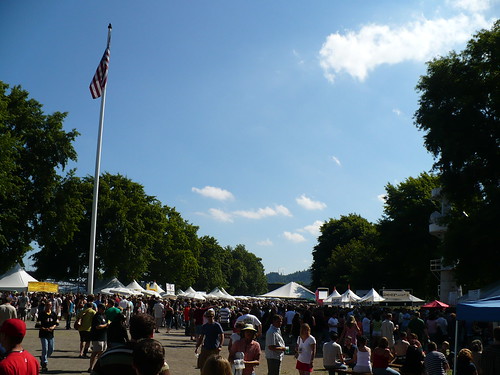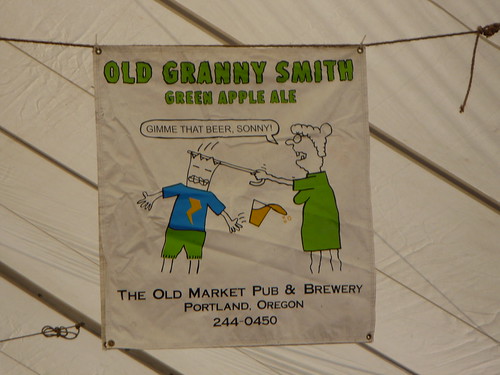Tuesday, August 7, 2007
Scapegoat the Train
An article in the Statesman via New York Times took some potshots at rail transit today. In fact it seems they were a planned hit, something from a Soprano's episode rather than looking at the facts. In this country we are sprawling into oblivion. Many of the developments on the periphery require new roads and addressing the congestion by expanding the roads is like loosening ones belt to lose weight. But if legislators give people a break by building a rail line, its seen as a waste when money could have gone to more roads? I'm sure thats where these phantom expert engineers want it to go.
Give me a break people. Billions upon billions of dollars go into the road system every year, 80% of which is paid for by the federal government for new roads, yet this reporter decides to take a pot-shot at real transit options including I'm assuming the Hiawatha Line. Well what other line carries people as such a lower cost per passenger mile? Not the automobile and roads. If you look at the cost of a freeway and the cost of the automobile the Hiawatha Line will win hands down, so why didn't they do an honest cost comparison? Because they were looking for a political scape goat.
This makes me so sick. I'm sick of all these half baked lies on the part of people who don't like transit. What is so wrong about not sprawling and giving people an alternative to the car? 32,000 people per day take that line. That is reducing GHGs and allowing people to save money. Possibly to the tune of $10,000 a year are saved per person if they get rid of their car. Building more roads instead of repairing them is your own problem. Don't blame it on expansion of capacity that could only come with a transit line instead of ripping down people's homes along the route just as they have done on I-10 in Houston. If you want a scapegoat, blame fellow citizens and government for allowing sprawl that doesn't pay for itself but requires more and more subsidy and road repair every year.
We're choking on our roads and transit is the lifeblood that regions need to live again. Road repairs are important, but don't give me that crap that transit is taking away from roads when there is a whole gas tax dedicated to fixing them. When the McArthur Maze fell down what came to the rescue? BART! In Minnesota, the Central Corridor would have looked really good right now if it were complete, but road monkeys have been sitting on transit expansion for decades. No one will ride it right? Hell yes they ride! Right now regions are choking on their own fat, the fat that is cars, highways, and a way of life based on wars for oil. It's time we got the facts instead of someone's factually incorrect opinion.
Monday, August 6, 2007
When the Bubble Pops
So when the housing market is down, what are the good investments? Apparently in New Jersey its housing near commuter rail stations. Easy access to transit and less housing cost is where people are going. According to realtors:
Homes along many of Central Jersey's commuter rail lines have a better chance of being sold than residences in more rural or suburban areas, according to real estate experts and housing statistics.
That's one of the conclusions drawn from a study of the sales numbers, which paint an uneven -- and depending upon where you live, unsettling -- picture of the Central Jersey housing market.
In some towns, the market is actually improving over last year, while in other areas, homes are languishing on the market even longer than in 2006, when the real estate bubble burst in earnest. Prices began to get soft in August 2005.
Hat Tip to Atrios & The Big Picture
Using Shame to Promote Good
The guilt trip was also used by a Judge in my neighborhood who is now a US Representative in the Houston area. But shame might also be useful in terms of environmental stewardship. What if people who let a certain amount of GHGs into the atmosphere had to put hello kitty on their cars? Well maybe not hello kitty but some sort of sign that they were producing more than their fair share of pollutants.
This is an idea I had for a public service commercial as well. "Carrying your carbon." And if you rode a bike you could carry a black marble but if you were riding a moped it would turn into a small brick. If you drove a huge SUV you would have a huge block on the top of your car. I'm not sure if it would work, but it would be interesting.
Sunday, August 5, 2007
Jan Gehl: Urban Mastermind
Asked during questions what he would do specifically for the city, Gehl said he would make pedestrians more comfortable in the city by adding street furniture, widening sidewalks and creating "oasises" for them. In addition, he would put immediate emphasis on better conditions for cyclists. And finally, he said attention should be paid to the mass transit system. Good mass transit and good pedestrian environments, he said, "are brothers and sisters," each depending on the other.
Saturday, August 4, 2007
Riding at Night
This doesn't just happen in the bay area though, a writer recently discussed this phenomenon for the Twin Cities.
There really is an issue with the light rail system not staying open until 2:15 or 2:30 am. There were two letters published on July 31 concerned with the "Minding the gap" article. The letters seemed to be arguing against the light rail staying open later and had some very weak points.First, there were suggestions to take a bus or taxi. But the buses run once every hour or so at that time, so you'd have to wait until 3 a.m. if you leave the bar at 2 a.m. Also, if you've ever been downtown and tried to take a cab at 2 a.m. you'd realize it takes over 20 minutes to finally flag one down -- and when you do it's a very expensive ride home. Most people just want to use the light rail at bar close, get closer to their homes and take a cab from there.
Thursday, August 2, 2007
Planned Streetcar Networks
Portland: Obviously their first line has been a success and now they are looking to expand. Citizen planning has already begun and a review of corridors will be underway shortly. They also have a leg up given the United Streetcar folks would make cars for them in town.
Seattle: Construction on the South Lake Union streetcar line is almost complete and there are plans for a more extensive network. There are maps in this report.
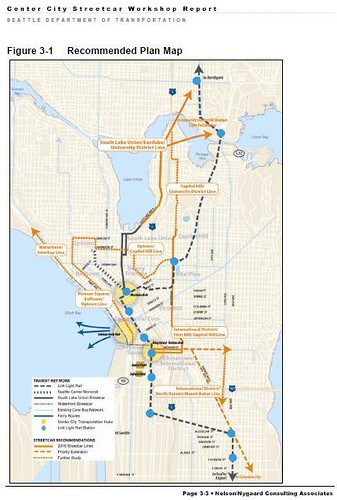
Minneapolis: After the success of the Hiawatha Line, Minneapolis is ready for expansion. They are in the third stage of planning for a streetcar network downtown that would consist of a number of corridors.
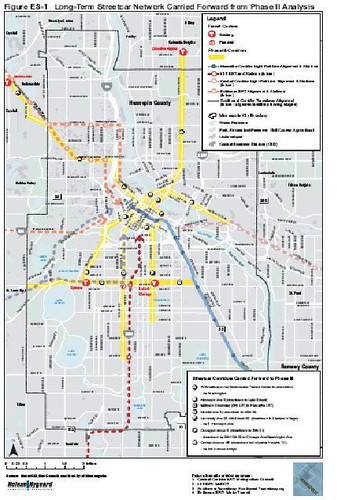
Washington DC: Plans for a streetcar network are beginning with the Anacostia Streetcar however they have hit a snag with some overhead wire rules that have been discussed earlier in the blog. But that hasn't stopped them from planning corridors or having the first streetcars tested.

Some cities such as Baltimore are hopeful, but haven't gotten into the planning stages yet.
I think its important to think big. As i've said before, one line does not a transit system make, and its important to have a network so people can go more places. Streetcars serve a certain short hop circulation service in street and can be used for shorter line haul operations but there are some jobs that light rail, commuter rail, heavy rail, or bus can do better. But there's nothing like a good land use plan and a streetcar to rebuild a neighborhood.
(Sorry for the picture quality, but I took screen shots from the linked PDFs)
Wednesday, August 1, 2007
Talking TOD With Peter Calthorpe
Here's a little of what he has to say in a podcast interview with Reconnecting America:
It’s interesting to me that in the age of the streetcar, you had low-density streetcar suburbs that worked just fine. I think that that kind of lifestyle can work, where you can get even moderate densities to be very effective in supporting transit systems. I don’t think we have to correlate high density apartment living with TODs, I think there can be townhouse neighborhoods and even small lot, single-family neighborhoods with transit systems. Once again, it’s the mix.I think that's a really important point. TOD doesn't need to be super dense everywhere to be effective. There is a general fear out there that planners are trying to change neighborhoods into 100 unit per acre condo towers. But that is simply not bearable in the Market.
Anyways, check out the interview.
Tuesday, July 31, 2007
8 Habits of Successful Commuter Rail Lines
Saturday, July 28, 2007
Portland Blogging
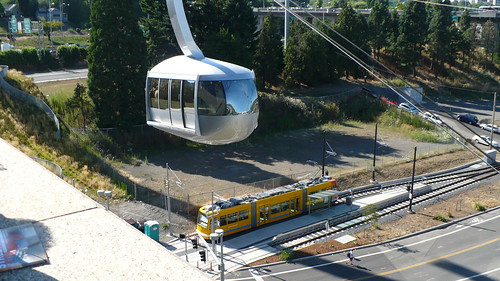
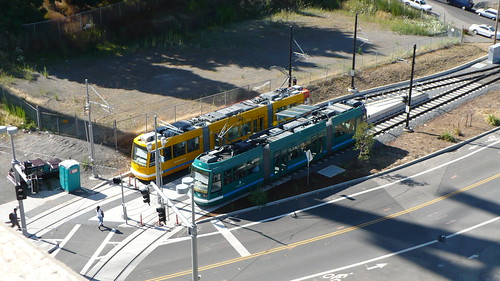
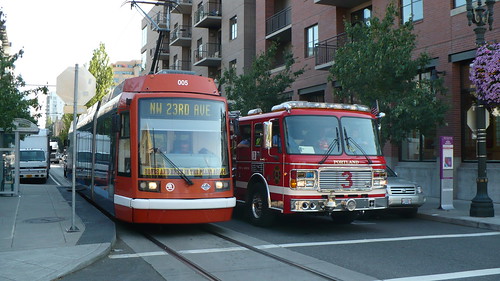
Here is a picture of a firetruck and a streetcar. It was pretty cool and they stayed there for a sec while I took a picture. I'm not sure if it was for me, but if it was, thanks!
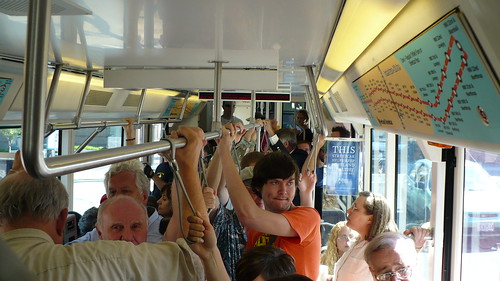
As with the F-Line, it was a crush load on a lot of the cars I saw. In fact it's so full during the afternoon that it's hard for some folks to get on. They need more operating funding so cars can run more often, because every 12 minutes doesn't quite cut it.

We went on the tram and got a testimonial from a doctor that was a skeptic before she started riding it. She said she wondered why they were spending so much money on it, but now she gets it. Instead of 30 minutes during rush hour to get between patient visits in the South Waterfront and OHSU campus, it now takes her 7. It's no surprise that its won her over. It's apparently won over folks who wanted to bike, but didn't like the hill.
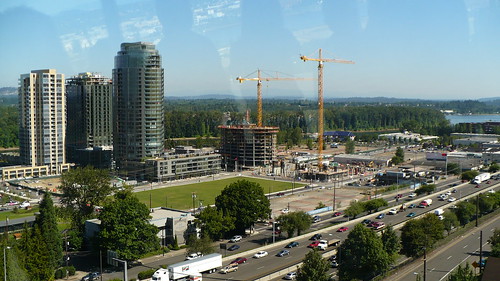
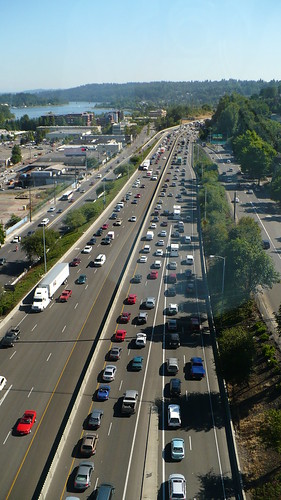
Here is traffic to Lake Oswego, better get that rapid streetcar sooner than later.
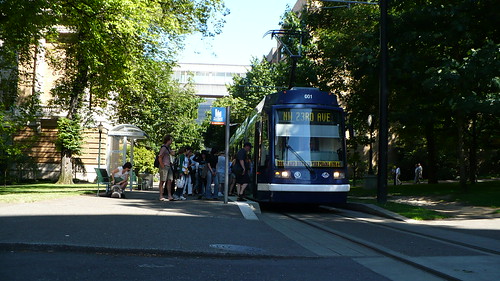
And here is a streetcar in the park for good measure. I'll update later as I upload more photos. Enjoy!!!
Freeway? No. Beerfest!
